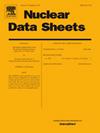High-precision Measurement of the 16O(n,n′γ) Cross Section using γ-ray Detection in Liquid Scintillators with H2O and BeO Targets
IF 2.7
1区 物理与天体物理
Q2 PHYSICS, NUCLEAR
引用次数: 0
Abstract
The 16O() reaction was measured at the Los Alamos Neutron Science Center white neutron source using γ-ray detection in liquid scintillators present in the upper hemisphere of the Correlated Gamma-Neutron Array for sCattering (CoGNAC). Separate measurements of this reaction were performed using H2O and BeO targets in successive years. The unique high energies of γ rays emitted from the 16O() reaction facilitated a clean selection of this reaction from threshold to 9.8 MeV incident neutron energy without the need for precise measurements of the γ-ray energy or the scattered neutrons. The precise time resolution of the liquid scintillator detectors was then exploited to obtain high-resolution incident neutron energy measurements, and good agreement was obtained between the H2O and BeO results reported here. The dominant literature data sets for this reaction have systematic differences between them, but the present results improve upon the neutron energy resolution of earlier measurements and show important discrepancies in recent data. Tentative data are also shown up to 20 MeV incident neutron energy but are potentially subject to improved understanding of the relative γ-ray and α decay branches from 16O excited states.
用γ射线检测水靶和BeO靶液体闪烁体16O(n,n′γ)截面的高精度测量
在美国洛斯阿拉莫斯中子科学中心(Los Alamos Neutron Science Center)的白中子源上,利用相关伽玛-中子散射阵列(CoGNAC)上半球液体闪烁体中的γ射线探测,测量了16O(n,n’γ)反应。在连续的几年中,用H2O和BeO靶分别对该反应进行了测量。从16O(n,n ' γ)反应中发射的γ射线的独特高能量有助于在不需要精确测量γ射线能量或散射中子的情况下,从阈值到9.8 MeV入射中子能量的干净选择该反应。然后利用液体闪烁体探测器的精确时间分辨率来获得高分辨率的入射中子能量测量,并且在这里报道的H2O和BeO结果之间得到了很好的一致性。该反应的主要文献数据集之间存在系统差异,但目前的结果改进了早期测量的中子能量分辨率,并显示了最近数据的重要差异。暂定数据也显示了高达20 MeV的入射中子能量,但可能需要改进对来自16O激发态的相对γ射线和α衰变分支的理解。
本文章由计算机程序翻译,如有差异,请以英文原文为准。
求助全文
约1分钟内获得全文
求助全文
来源期刊

Nuclear Data Sheets
物理-物理:核物理
CiteScore
7.80
自引率
5.40%
发文量
22
审稿时长
>12 weeks
期刊介绍:
The Nuclear Data Sheets are current and are published monthly. They are devoted to compilation and evaluations of experimental and theoretical results in Nuclear Physics. The journal is mostly produced from Evaluated Nuclear Structure Data File (ENSDF), a computer file maintained by the US National Nuclear Data Center
 求助内容:
求助内容: 应助结果提醒方式:
应助结果提醒方式:


